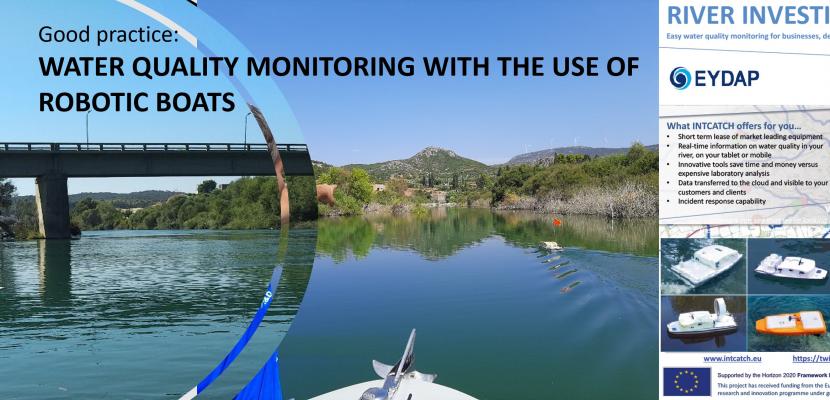Image

WATER QUALITY MONITORING WITH THE USE OF ROBOTIC BOATS
Published on 14 September 2020

Greece
This is the good practice's implementation level. It can be national, regional or local.
About this good practice
According to the River Basin Management Plans, it is of great importance to preserve water quality conditions and if possible, upgrade the ecological and chemical status. Current monitoring strategies are highly susceptible to hazardous events, such as direct discharge of sewage or run-off from agricultural areas. Such events occur occasionally and are often not reflected by fixed date measurements and the results of those investigations are in many instances poor in terms of data density. A more detailed investigation is necessary in order to correlate pressures with the impacts to water quality and therefore, it is very important to afford early warning systems that can measure real-time parameters which can be associated with possible pollution.
EYDAP’s innovative strategy by using robotic boats could increase available water quality data in real-time, without requiring labor-intensive and costly monitoring schemes. This highly promising and target-oriented approach uses autonomous boats equipped with appropriate sensors (Chl-a, Intelligent Spectral Analyzer, DO, pH, EC). In Kifissos river, the main river of Attica region in Greece, the robotic boat covered almost 2 km, reaching the mixing zone of the river with the sea, identifying interesting profiles of the physicochemical parameters that were monitored.
Beneficiaries of INTCATCH service are Public Authorities (Ministries, Prefectures, Municipalities), Academic Community, Institutes of Inland Waters and all citizens.
EYDAP’s innovative strategy by using robotic boats could increase available water quality data in real-time, without requiring labor-intensive and costly monitoring schemes. This highly promising and target-oriented approach uses autonomous boats equipped with appropriate sensors (Chl-a, Intelligent Spectral Analyzer, DO, pH, EC). In Kifissos river, the main river of Attica region in Greece, the robotic boat covered almost 2 km, reaching the mixing zone of the river with the sea, identifying interesting profiles of the physicochemical parameters that were monitored.
Beneficiaries of INTCATCH service are Public Authorities (Ministries, Prefectures, Municipalities), Academic Community, Institutes of Inland Waters and all citizens.
Resources needed
The project, INTCATCH, H2020-WATER-2014-2015, H2020-WATER-2015-two-stage, WATER-1b-2015, has a budget of 7,570,335 €.
Evidence of success
Allows monitoring of ecological status more accurately with emphasis on phytoplankton growth.Achieves a more thorough monitoring campaign both in space and time and provides significantly higher amount of water quality data without requiring labour-intensive and costly monitoring schemes.Allows the collection of many discrete samples and provides a more representative coverage of the river or lake than current monitoring programs.Especially for Lake Yliki,is proved that is actually mesotrophic.
Potential for learning or transfer
EYDAP SA continues to demonstrate the successful INTCATCH boats in other water catchments. It was shown that with their use we were able to cover the whole area of Lake Pamvotis and possible pollution discharges in two days. It took only one morning to evaluate water quality of Kifissos river estuaries in Athens. It was shown to greek stakeholder network that the INTCATCH boats can successfully cover the need for spatial and temporal measurements of physicochemical parameters such as DO, pH, T, EC, chlorophyll-a, nutrients supported by an autonomous sampling system. Thanks to their ability to use on-site measurements by easy-to-use appropriate sensors, boats could be valuable and extremely useful in:
-dams and low flow areas
-supporting automatic telemetric stations
-supporting spatial distribution of water quality data (e.g. chl-a, turbidity) with Landsat satellite images
-enhancing monitoring programs requiring a high frequency of measurements such as drinking water reservoirs
-dams and low flow areas
-supporting automatic telemetric stations
-supporting spatial distribution of water quality data (e.g. chl-a, turbidity) with Landsat satellite images
-enhancing monitoring programs requiring a high frequency of measurements such as drinking water reservoirs
Further information
Website
Good practice owner
You can contact the good practice owner below for more detailed information.
Organisation
Region of Attica

Greece
Attiki
